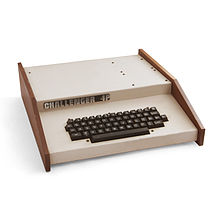- Ohio Scientific
-
Ohio Scientific Inc. (also known as Ohio Scientific Instruments) was a United States computer company that built and marketed computers from the late 1970s to the early 1980s. The company was founded by Mike and Charity Cheiky in 1975 in Hiram, Ohio.[1]
Contents
Products
One of their first products, launched in 1978 was the OSI Model 500 system, a very simple single board computer based on the MOS Technology 6502 microprocessor, but lacking a Video Display Controller. It needed an external video terminal such as the VT100, or the CT-64 terminal system from SWTPC, to create a useful system. Their later products were also 6502-based, the Superboard II, Challenger 1P, Challenger 2P, Challenger 4P and Challenger 8P, introduced in 1979 and discontinued in 1981.
Original Ohio Scientific motherboard designs used 7400-series transistor-transistor logic TTL chips. Instead of using a floppy disk controller IC, they used the Motorola 6850 ACIA serial-port UART chip, which made their 8 and 5 inch floppies unreadable on any other system.
The company supplied full schematics of their hardware,which allowed for some field modifications, such as increased clock speed and increased video line length.
The video systems did not have color-graphics like the Apple II, just upper-case text, and some pseudo graphical characters, (comparable to the "PETSCII" character-set of the Commodore PET) for drawing lines and supporting simple games. They hadn't figured out how to write to the video memory without glitching the display, so the hardware would blank the screen for a few microseconds while it accessed the video memory. There was an add-on graphics card for the Superboard that would display 256 by 256 pixels. It came with software to draw 3D graphics.
The version OSI C1P / 600D Superboard II (occasionally advertised as the 'Colorboard') featured an unpopulated socket for an extra 1k x 4-bits of video ram to hold character colour information. The implementation of this was detailed in the OSI user group newsletter which was published around four times a year. The 600D also featured two video modes: 32x32 (~24x24 visible) for 'graphics', or 64 x 16 (~48x15 visible) for text where each text line had a blank line between it and the next. The mode could be selected by a poke to the keyboard register. The keyboard polling register (a simple 8-bit TTL Latch) was also used as a very crude digital to analogue converter by means of a resistor ladder connected to an 'audio out' socket to the right of the keyboard.
The original superboard shipped with an 4KB O.S. in ROM, known as SYNMON, as the rom was labelled 'SYN600', and a rather buggy version of Microsoft 8K basic. Mainly due to the popularity of the superboard clone 'UK-101' in the UK, the bugs in the BASIC roms were eventually fixed, and at least two third-party companies produced their own version of the OS. One version was called 'CEGMON', the other was 'WEMON' produced by Watford Electronics in the UK. Both featured full screen editing (almost identical to the commodore PET), Named cassette file handling (like the PET) and a greatly Improved machine code monitor (also very similar to the Commodore PET).
Software was also minimal: a cassette boot loader in ROM and Microsoft BASIC in ROM. Disk-based systems included a bare-bones "Disk Operating System", which did not have file names, only disk track numbers. Users were advised to reserve track 40 as a text area for a manual disk directory. Even so, the disk was much handier than reading and writing cassettes at 1200 baud.
The OSI Challenger III had three processors: a 6502, a 6800, and a Z80. These were software switchable, but only one would be running at a time. Because it had a Z80, the Challenger III could run CP/M, but it booted up in 6502 mode, and the bootstrap would switch processors.
The operating systems which ran on the CIII were OSI CP/M, OS-65D, and OS-65U. All three OS's, at least in the later versions, had directories with file names.
OSI/CPM had an assembler, FORTRAN and COBOL compiler, but to make a copy of the CPM, one had to boot in OS-65D to copy the disk. OS-65D had a Basic interpreter, Assembler, Editor, disassembler, and disk copy utility. OS-65U had a Basic interpreter, and had some simple networking capability, but assembly programs had to be done in OS-65D and then ported over.
History
Mar 1981 OSI is sold to M/A-Com Inc. of Burlington MA. OSI will concentrate on business systems.
May 1982 OSI name is changed to M/A-Com Office Systems Inc.
See also
The Compukit UK101 is virtually a clone of the Ohio Scientific superboard
References
- ^ Allan, Roy A (2001). "Transition to Microcomputers". A History of the Personal Computer. Allan Publishing. ISBN 0968910807. http://www.retrocomputing.net/info/allan/eBook04.pdf.
External links
Categories:- Early microcomputers
- Companies established in 1975
Wikimedia Foundation. 2010.


